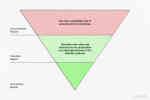Step 2 of 3•8 minutes read
Why Assess Risks?
This pyramid tells us that if we can avoid any unsafe working practices, we will reduce the number of incidents, accidents and fatalities. The best way to find unsafe working practices is by assessing all work situations on board for risks. Some laws and regulations require you to do risk assessments in some cases.

The pyramid shows the connection between the workplace and the risk of incidents or fatalities.
Risk Assessment
A risk assessment is a careful examination of what can cause harm, to facilitate decisions regarding precautions to take. The aim is to minimise accidents and improve health on board. The risk assessment should initially establish the hazards present at the place of work and identify the significant risks of the work activity.
The assessment should take into account any existing precautions to control the risk - such as permits to work, restricted access, use of warning signs, agreed procedures and personal protective equipment.
There are four steps in performing a risk assessment:
What Can Go Wrong? – Identify the Hazard!
All real and potential sources of danger must be identified by experienced personnel and include historic data. What possible hazardous scenarios can occur? This will require experience and imagination on the part of the person carrying out the risk assessment. Any possible scenarios should be considered, regardless of how unlikely they may seem. All available information regarding hazards must be used. Statistics and accident reports are only two of the numerous sources of information for this.
How Bad Can It Be?– Assess the Risk!
By estimating the consequence and frequency of a given situation the risk can be assessed. If one or both of the above is high, the risk will most probably be too high and either the frequency or consequence must be reduced before performing the work.
In many cases the risk can not be completely removed from a scenario; however, the risk can be reduced to an acceptable level. In most cases, this is done by reducing the likelihood since this often is easier than reducing the consequence.
For example, one of the risks while walking in an obstructed area can be falling. To reduce the likelihood, the obstruction can be marked in a contrasting colour. To reduce the consequence, protective wear such as hard hats can be worn.
What Can We Do About It? – Prepare Safeguards to Control It!
Safeguards can be divided into 'hard' safeguards that are designed to prevent the possibility of faults and 'soft' safeguards that are not physical but are sets of rules and procedures preventing the possibility of faults. Hard safeguards are always more effective than soft ones. One example of a 'hard' safeguard is the load program that prevents too quickly an increase of the engine revolutions; obviously, this is much more effective than a warning sign saying 'Increase slowly' posted at the engine control.
Do It! – Act on Implementing the Safeguards!
Implement the safeguards before starting the work. If you have found a "hard" safeguard and cannot implement this immediately, you may have to use procedures or PPE in the meantime.

The ALARP Triangle, which stands for "as low as reasonably practicable".
Can we Reduce all Risks to Zero?
It is not possible to eliminate all risks.
Risk should be reduced to a level that is as low as is reasonably practicable (ALARP).
If a "tolerable" level of risk can be reduced further at a reasonable cost and with little effort, then it should be implemented. Standards of tolerability tend to be far stricter after an accident than before.
When deciding on priorities for the application of controls, the frequency of the activity should also be taken into account; for example, it may be more urgent to address a 'moderate' level of risk in a process that occurs every day than to impose controls over an activity that involves 'substantial' risk but will not be carried out shortly.